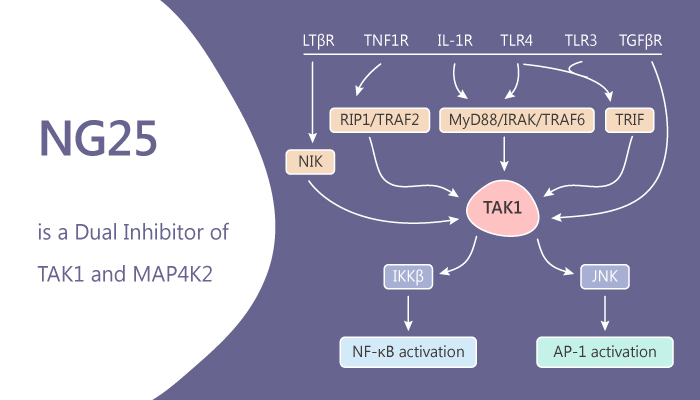TAK1 is also called Mitogen-activated protein kinase kinase kinase 7 (MAP3K7). It belongs to the serine/threonine protein kinase family. The kinase regulates cell death, and its activation is through a serious of intracellular and extracellular stimuli. TAK1 forms complex in response to IL-1, such as MAP3K7P2/TAB2 and TRAF6, MAP3K7P1/TAB1. The complex calls for NF-κB activation.
MAP4K2 is the abbreviation of mitogen-activated protein kinase kinase kinase kinase 2. It is also a member of serine/threonine protein kinase family. TNF-alpha induces MAP4K2 activation. MAP4K2 causes activation of MAP kinases.
In recent years, scientists found NG25 as a potent dual TAK1 and MAP4K2 inhibitor. It shows IC50s of 149 nM and 21.7 nM, respectively. The inhibitor also displays inhibitory activity against other kinases, such as LYN, CSK, FER, p38α, ABL, ARG and SRC. The corresponding IC50s are 12.9, 56.4, 82.3, 102, 75.2, and 113 nM, respectively.

In addition, NG25 (400 nM) completely blocks CpG B- or CpG A-stimulated secretion of IFNα and CL097-stimulated secretion of IFNβ. It suppresses IKKα/IKKβ activation. The blockage of activation of STAT1 is due to inhibition of IFNβ secretion. Moreover, the compound is non-cytotoxic to cell at a concentration of 400 nM.
Furthermore, NG25 inhibits IKKβ activation by TLR7 and TLR9 agonists. The latter two ligands induce secretion of type 1 IFNs. As expected, NG25 prevents the secretion.
References:
1. Tan L, et al. J Med Chem. 2015 Jan 8;58(1):183-96.
2. Pauls E, et al. J Biol Chem. 2012 Jun 1;287(23):19216-28.